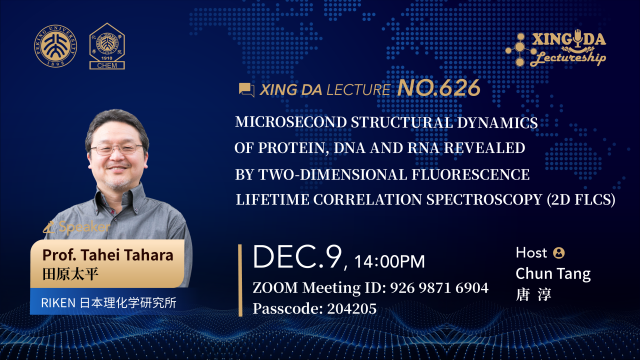Speaker: Prof. Tahei Tahara, Molecular Spectroscopy Laboratory, RIKEN
Host: Prof. Tang Chun, Peking University
Time: 14:00 pm, December 9, 2022, GMT+8
Venue: Zoom Meeting ID: 926 9871 6904 Passcode: 204205
Abstract:
Single-molecule spectroscopy, combined with fluorescence resonance energy transfer, has been intensively utilized for studying structural dynamics of protein, DNA, and RNA on the sub-millisecond to second timescales. However, observation of the dynamics on the microsecond timescale is still very challenging due to the low efficiency of collecting photons from a single molecule. The microsecond timescale is very important because the elementary processes of the structural change of bio-mactromolecules take place on this time scale, and direct comparison between experiment and simulation is possible. To realize quantitative investigations of structural dynamics on the microsecond timescale, we developed novel single molecule spectroscopy, i.e., two-dimensional fluorescence lifetime correlation spectroscopy (2D FLCS). In this 2D FLCS, we use a high-repetition short pulse laser for photoexcitation and analyze the fluorescence lifetime from the donor of a FRET pair, instead of analyzing the FRET efficiency evaluated from the intensity ratio between the donor and acceptor fluorescence. More concretely, we first obtain the correlations of the photon pairs with respect to the excitation-emission delay times in a form of a two-dimensional (2D) map, and then the 2D map is converted to the correlations between different species that have different fluorescence lifetimes using inverse Laplace transformation. 2D FLCS is capable of visualizing the structural dynamics of complex molecules in the equilibrium condition with a sub-microsecond time resolution at the single-molecule level.
In this presentation, I will talk about the principle of 2D FLCS and its application to the study of the structural dynamics of protein, DNA, and RNA, in particular, the most recent study on the folding/unfolding dynamics of an RNA riboswitch. 2D FLCS clearly showed that the folding/unfolding mechanism of the riboswitch is changed from conformational selection to induced-fit, with the presence of the cofactor or ligand. Based on the observed microsecond folding dynamics, we proposed the molecular-level mechanism for transcription control by the riboswitch. If time allows, I also mention a recent technical extension of 2D FLCS, which enabled us to examine the structural dynamics on a wide time scale from microsecond to sub-second, keeping the sub-microsecond time resolution.
Source: College of Chemistry and Molecular Engineering
